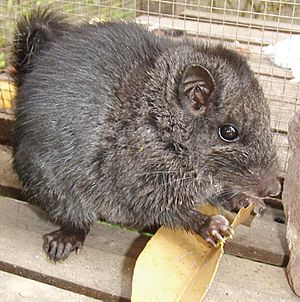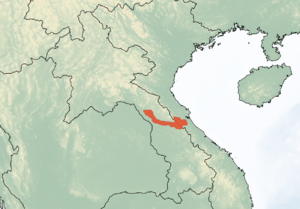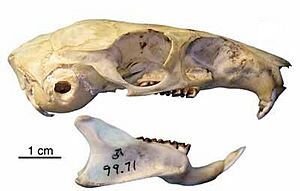Laotian rock rat facts for kids
Quick facts for kids Laotian rock ratTemporal range: Late Miocene-Recent
|
|
|---|---|
 |
|
| Young male | |
| Conservation status | |
| Scientific classification | |
| Genus: |
Laonastes
|
| Species: |
aenigmamus
|
 |
|
The Laotian rock rat, also known as kha-nyou (pronounced "ka-nyoo"), is a unique rodent that lives in the Khammouan region of Laos. People sometimes call it the "rat-squirrel" because of its appearance. Scientists first officially described this animal in 2005. They were so surprised by how different it was, they thought it belonged to a brand new animal family!
However, in 2006, other scientists looked closer. They believed the Laotian rock rat actually belonged to a very old family of rodents called Diatomyidae. This family was thought to have died out about 11 million years ago! This makes the Laotian rock rat a "Lazarus species"—like an animal that came back from the dead. These creatures look like large, dark rats. They have thick, hairy tails, much like a squirrel. Their skulls are very special, with features not seen in other living mammals.
Contents
A Special Place in the Animal Kingdom
When scientists first found the Laotian rock rat, they thought it was incredibly unique. In 2005, Paulina Jenkins and her team believed it was so different from all other living rodents that it needed its own new animal family. Finding a completely new family of living mammals is very rare! Before this, the last time Western scientists found a new mammal family was in 1974, with the bumblebee bat.
The "Lazarus Species" Discovery
Later, in 2006, another group of scientists led by Mary Dawson studied the rock rat more closely. They compared it to old fossils. They discovered that the Laotian rock rat looked very similar to an ancient family of rodents called Diatomyidae. This family was thought to have died out about 11 million years ago!
This meant the Laotian rock rat wasn't a new family at all. Instead, it was a living member of a family everyone thought was extinct. Scientists call such an animal a "Lazarus species". It's like finding a dinosaur alive today! There was a huge gap of 11 million years in the fossil record where no animals from this family were found. Mary Dawson even called it the "coelacanth of rodents," referring to another famous "living fossil" fish.
How DNA Helps
Scientists also used DNA to understand where the Laotian rock rat fits. Early studies suggested it was related to some African rodents. However, later, more detailed DNA studies showed something different. These studies, which looked at many genes, found that the Laotian rock rat is closely related to a group called Ctenodactylidae. This means its family split off from other rodents a very long time ago, about 44 million years ago.
What's in a Name?
The scientific name for this animal is Laonastes aenigmamus.
- The first part, Laonastes, comes from Greek words. It means "inhabitant of stone." This name makes sense because the animal lives among limestone rocks in Laos.
- The second part, aenigmamus, means "enigma mouse." An "enigma" is a mystery. This part of the name refers to how puzzling its place in the rodent family tree was to scientists at first.
How the Laotian Rock Rat Was Found
The story of how the Laotian rock rat was discovered is quite interesting!
- In 1996, the first examples of these animals were found. They were seen for sale as meat at a market in Thakhek, Khammouan, in Laos.
- Later, in 1998, scientists got more animal remains from local villagers. They even found some in an owl pellet (which is what owls spit up after eating).
- Researchers from the Wildlife Conservation Society went back to Laos. They found more specimens. These new findings made scientists think the animals might not be as rare as they first believed.
- On June 13, 2006, a professor named David Redfield and a Thai wildlife biologist, Uthai Treesucon, made an exciting announcement. They had successfully captured, photographed, and even videotaped a live Laotian rock rat in a village called Doy in Laos!
What Does It Look Like?
The Laotian rock rat generally looks like a large rat.
- It has a thick, furry tail that looks a bit like a squirrel's, but it's not as bushy.
- Its head is quite big, with round ears. It has a slightly rounded nose and very long whiskers.
- The fur on its body is a dark slate grey color. Its tail is almost black.
- The belly is lighter, with a small white patch in the middle.
- Its eyes are small, round, and black.
- These animals are about 26 centimeters (about 10 inches) long. Their tail adds another 14 centimeters (about 5.5 inches). They weigh around 400 grams (about 0.9 pounds).
- Scientists have studied its skull and jaw structure very carefully. These features are part of what makes it so unique among rodents.
Where Do They Live?
The Laotian rock rat lives in specific areas of Southeast Asia.
- You can find them in the limestone karst regions of Khammouan Province and southern Bolikhamxai Province in Laos.
- They also live in a small part of western Quảng Bình Province in Vietnam.
- In Vietnam, they are found in places like Phong Nha – Kẻ Bàng National Park.
- They also live across the border in Laos, in the Hin Namno National Biodiversity Conservation Area.
- Scientists think that the groups of rock rats in different areas might be a bit different from each other. They might even be different types of the same species!
Life in the Rocks
Laotian rock rats prefer to live in areas with karst limestone formations.
- They are usually found among large limestone boulders on hillsides.
- Local villagers know these animals well and call them kha-nyou.
- Scientists believe these rock rats are nocturnal, meaning they are most active at night.
What Do They Eat?
These rock rats are mainly herbivores. This means they eat plants.
- Their diet mostly includes leaves, grass, and seeds.
- They might also eat some insects, but plants are their main food source.
Reproduction and Movement
- Female Laotian rock rats usually give birth to one baby at a time.
- These animals are generally calm and move slowly on flat ground.
- They walk with their feet spread out, almost like a duck. This special way of walking helps them climb and move easily across large, uneven rocks. The angle of their feet gives them a better grip on rocky surfaces.
See also
 In Spanish: Rata de roca laosiana para niños
In Spanish: Rata de roca laosiana para niños



